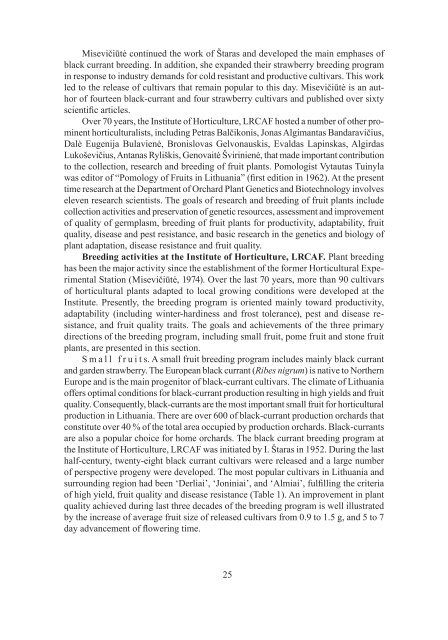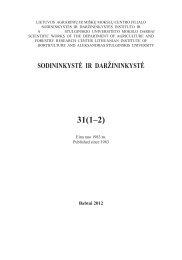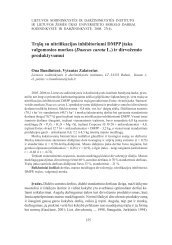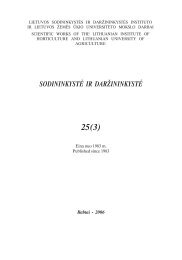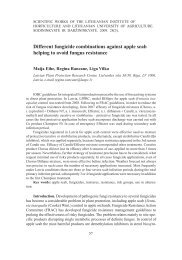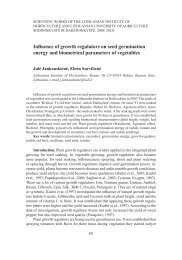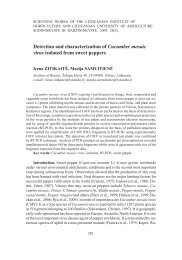sodininkystÄ ir daržininkystÄ 32(3â4)
sodininkystÄ ir daržininkystÄ 32(3â4)
sodininkystÄ ir daržininkystÄ 32(3â4)
- No tags were found...
Create successful ePaper yourself
Turn your PDF publications into a flip-book with our unique Google optimized e-Paper software.
Misevičiūtė continued the work of Štaras and developed the main emphases ofblack currant breeding. In addition, she expanded the<strong>ir</strong> strawberry breeding programin response to industry demands for cold resistant and productive cultivars. This workled to the release of cultivars that remain popular to this day. Misevičiūtė is an authorof fourteen black-currant and four strawberry cultivars and published over sixtyscientific articles.Over 70 years, the Institute of Horticulture, LRCAF hosted a number of other prominenthorticulturalists, including Petras Balčikonis, Jonas Algimantas Bandaravičius,Dalė Eugenija Bulavienė, Bronislovas Gelvonauskis, Evaldas Lapinskas, Alg<strong>ir</strong>dasLukoševičius, Antanas Ryliškis, Genovaitė Šv<strong>ir</strong>inienė, that made important contributionto the collection, research and breeding of fruit plants. Pomologist Vytautas Tuinylawas editor of “Pomology of Fruits in Lithuania” (f<strong>ir</strong>st edition in 1962). At the presenttime research at the Department of Orchard Plant Genetics and Biotechnology involveseleven research scientists. The goals of research and breeding of fruit plants includecollection activities and preservation of genetic resources, assessment and improvementof quality of germplasm, breeding of fruit plants for productivity, adaptability, fruitquality, disease and pest resistance, and basic research in the genetics and biology ofplant adaptation, disease resistance and fruit quality.Breeding activities at the Institute of Horticulture, LRCAF. Plant breedinghas been the major activity since the establishment of the former Horticultural ExperimentalStation (Misevičiūtė, 1974). Over the last 70 years, more than 90 cultivarsof horticultural plants adapted to local growing conditions were developed at theInstitute. Presently, the breeding program is oriented mainly toward productivity,adaptability (including winter-hardiness and frost tolerance), pest and disease resistance,and fruit quality traits. The goals and achievements of the three primaryd<strong>ir</strong>ections of the breeding program, including small fruit, pome fruit and stone fruitplants, are presented in this section.S m a l l f r u i t s. A small fruit breeding program includes mainly black currantand garden strawberry. The European black currant (Ribes nigrum) is native to NorthernEurope and is the main progenitor of black-currant cultivars. The climate of Lithuaniaoffers optimal conditions for black-currant production resulting in high yields and fruitquality. Consequently, black-currants are the most important small fruit for horticulturalproduction in Lithuania. There are over 600 of black-currant production orchards thatconstitute over 40 % of the total area occupied by production orchards. Black-currantsare also a popular choice for home orchards. The black currant breeding program atthe Institute of Horticulture, LRCAF was initiated by I. Štaras in 1952. During the lasthalf-century, twenty-eight black currant cultivars were released and a large numberof perspective progeny were developed. The most popular cultivars in Lithuania andsurrounding region had been ‘Derliai’, ‘Joniniai’, and ‘Almiai’, fulfilling the criteriaof high yield, fruit quality and disease resistance (Table 1). An improvement in plantquality achieved during last three decades of the breeding program is well illustratedby the increase of average fruit size of released cultivars from 0.9 to 1.5 g, and 5 to 7day advancement of flowering time.25


